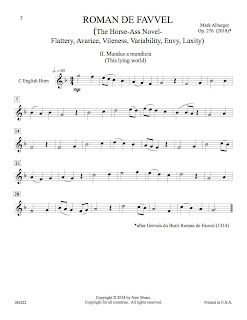[Things are not always what they seem, when George Gershwin paints a picture of Arnold Schoenberg, or when Quiz 10 (Counterpoint) takes place, some time after 8am, Thursday, April 5, at Diablo Valley College Music, Pleasant Hill, CA]
C#, G#, D# Minor; B Major
https://en.wikipedia.org/wiki/C-sharp_minor
https://en.wikipedia.org/wiki/G-sharp_minor
https://en.wikipedia.org/wiki/D-sharp_minor
https://en.wikipedia.org/wiki/B_major
Added Tone Chords
Any Chord including non-tertian (non-3rd) elements (usually 2nds)
in a tertian setting (stack of thirds)
Added Sixth Chord = Root, 3rd, 5th, 6th (ex. C-E-G-A)
Traditionally, this would be considered a First-Inversion Seventh Chord
(Root Position of above ex. A-C-E-G), but 20th/21st-Century usages suggest otherwise...
https://en.wikipedia.org/wiki/Added_tone_chord
https://en.wikipedia.org/wiki/Sixth_chord
Four Textures of Music
Monophony - one line of music, strictly performed
Heterophony - one line of music, freely performed
Polyphony - more than one line of music, lines of relatively equal importance
Homophony - more than one line of music, with one line predominating
https://en.wikipedia.org/wiki/Monophony
https://en.wikipedia.org/wiki/Heterophony
https://en.wikipedia.org/wiki/Polyphony
https://en.wikipedia.org/wiki/Homophony
Harmony
The vertical aspects of simultaneously sounding pitches,
particularly in homophonic writing.
https://en.wikipedia.org/wiki/Harmony
Counterpoint
The horizontal (melodic) aspects of simultanously sounding pitches,
particularly in polyphonic writing, including added-tone considerations.
Species Counterpoint (codified by Johann Joseph Fux in Gradus ad Parnassum, 1725),
are stylistic conventions based upon Giovanni Pierluigi da Palestrina's late-Renaissance compositions,
most easily evaluated in two-part writing (ex. Soprano against Bass)
First Species - Note against Note (ex. Quarter above Quarter)
Second Species - Two Notes against One Note (ex. 2 Eighths above a Quarter)
Third Species - Four Notes against One Note (ex. 4 Sixteenths above a Quarter)
(so much for triplets, quintuplets, etc.!)
Fourth Species - Notes offset against one another in Suspensions (see below)
Fifth Species - Florid Counterpoint, a combination of all of the above.
https://en.wikipedia.org/wiki/Counterpoint
https://en.wikipedia.org/wiki/Johann_Joseph_Fux
Even More on Non-Chord / Non-Harmonic / Embelishing / Added Tones
Added Tones may be Accented (downbeats / strong beats) or Unaccented (upbeats / weak beats).
In multiple part-writing (ex. SATB),
it is possible to have multiple simultaneous Passing and/or Neighboring Tones.
An Incomplete Neighbor which follows Chord Tone may be called an Escape Tone (Echapee)
It is possible to have sequential Upper and Lower Incomplete Neighbors both referring back to the
same chord tone - these can also be called Changing Tones (and non-strictly as a Cambiata)
Suspension - the prolongation of a chord tone over a change of harmony
usually a suspension will resolve by dropping stepwise eventually into the new chord,
however, if the original chord is re-established, the tone can remain static.
A suspension that resolves upward can be called a retardation.
https://en.wikipedia.org/wiki/Nonchord_tone#Escape_tone
https://en.wikipedia.org/wiki/Changing_tones
https://en.wikipedia.org/wiki/Nonchord_tone#Suspension
More Intervals
Augmented Unison = A1 = 1/2 step notated as two versions of the same letter name
(ex. A A#) = a Chromatic Half-Step - Enharmonic equivalent of m2 (ex. A Bb)
Augmented Second = A2 = 1 1/2 steps notated with 2 letter names
(ex. A B#) - Enharmonic equivalent of m3 (ex. A C)
Diminished Fourth = d4 = 2 1/2 steps notated over a span of 4 letter names
(ex. A Db) - Enharmonic equivalent of M3 (ex. A C#)
Keyboard-Solfege
Sergei Prokofiev (1891-1953) - Peter and the Wolf, Op. 67 (1936): Peter's Theme
Treble Clef - Sol Do Mi Sol La Sol (Arpeggiated 2nd-Inversion Cadd6!)
R.H. 1 2 3 4 5 4 (pivot-roll fingers toward the right gracefully!)
https://www.youtube.com/watch?v=5PkEkxMb2yI
https://en.wikipedia.org/wiki/Sergei_Prokofiev
https://en.wikipedia.org/wiki/Peter_and_the_Wolf
Chord Realization / Performance
I, IV, and V Chords in C and Eb
Other Music Referenced in Quiz 10 (Counterpoint)
Anton Webern (1883-1945) - Cantata No. 1 (1939)
https://www.youtube.com/watch?v=tzam7GfPRTY
http://imslp.org/wiki/Kantate_I,_Op.29_(Webern,_Anton)
George Gershwin (1898-1937)
https://en.wikipedia.org/wiki/George_Gershwin
Rhapsody in Blue (1924)
https://www.youtube.com/watch?v=N2_yRwPPIEc
https://en.wikipedia.org/wiki/Rhapsody_in_Blue
http://imslp.org/wiki/Rhapsody_in_Blue_(Gershwin,_George)
Three Piano Preludes (1926): II
https://www.youtube.com/watch?v=PzzIwVh9-jE
https://en.wikipedia.org/wiki/Three_Preludes_(Gershwin)
http://imslp.org/wiki/3_Preludes_(Gershwin%2C_George)
Porgy and Bess (1935): Summertime
https://www.youtube.com/watch?v=O7-Qa92Rzbk
https://en.wikipedia.org/wiki/Porgy_and_Bess
https://en.wikipedia.org/wiki/Summertime_(George_Gershwin_song)
http://imslp.org/wiki/Porgy_and_Bess_(Gershwin%2C_George)
Kurt Weill (1900-1950) - The Threepenny Opera (1928): Ballad of Mack the Knife
https://www.youtube.com/watch?v=Y1jwoHk8D28
https://en.wikipedia.org/wiki/Kurt_Weill
https://en.wikipedia.org/wiki/The_Threepenny_Opera
https://en.wikipedia.org/wiki/Mack_the_Knife
http://imslp.org/wiki/Die_Dreigroschenoper_(Weill%2C_Kurt)
***
After one of the worst inclement-weather, traffic-smitten drives of the season,
arrive at Diablo Valley College, Pleasant Hill, 2 minutes late to empty parking lots. With definitely something up, unlock the vacant Music Building and classroom, deciding to check for text messages. Sure enough, some sort of incident, with the campus closed for the day.
Evincing a truly academic mindset, lament the loss of a teaching day, though surely the bit of extra unscheduled time is welcome in editing page 61 new-edition Mice and Men, Op. 45.
Brave the less-congested, but still very damp, reverse transit, producing parts for
ROMAN DE FAVVEL
(The Horse-Ass Novel -
Flattery, Avarice, Vileness, Variability, Envy, Laxity), Op. 276
after Gervais de Bus's Roman de Fauvel (Faus Vel - Falseness), 1314
Book I, Folio 1-2
II. Mundus a mundicia (This lying world… 2-voice Notre Dame conductus hybrid motet)...
on the at-last clearing 67th day of summer, high down 2 to 64 (Pleasant Hill, 63; .69 additional rainfall, 13.37 since July 1)...









